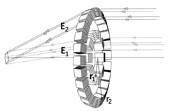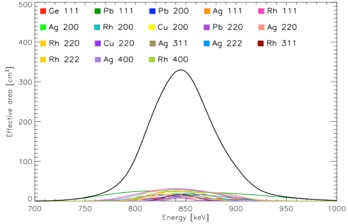The Laue-Lens Optic (LLO)
A Laue lens offers the unique possibility of concentrating gamma rays from a large collection area onto a small focal spot. The dramatically improved signal to background ratio leads to outstanding sensitivity. DUAL’s Laue-Lens Optic (LLO) focuses in the 800 keV-900 keV energy band, relevant for the detection of the 56Co line of SN1a. It is composed of 5800 crystals glued onto a CeSiC monolithic substrate. The total weight amounts to 80 kg, the outer diameter is 98 cm.
Instrument conceptual design and key characteristics

The LLO is composed of 5800 crystals arranged in 32 concentric rings. Each ring is populated by identical crystals, the axis of symmetry of the rings defining the optical axis of the lens. The characteristics of the LLO are presented in Table 8. The crystals are glued onto a CeSiC monolithic substrate that combines many properties. Beside being space qualified, this material have excellent mechanical stability and thermal conductivity, is lightweight and have an absorption lower than 6% at 850 keV (for a thickness of 3 mm). The effective area of the LLO is shown in Figure 19. It peaks at 340 cm2 at 847 keV. At the focus, 62% of the signal is concentrated in a disc of 7 mm of radius (1.54 cm2), which represents a concentration factor of ~ 220.

Effective area of the LLO. This calculation assumes crystals oriented within 10 arcsec of their nominal angle (1 sigma, Gaussian distribution), and takes into account the absorption of the substrate (3 mm of CeSiC). The crystals are modeled using Darwin’s model of mosaic crystals fed with experimentally determined parameters (Barriere et al, 2010).
Description of the measurement technique – pointing requirement
SNeIa are first discovered in visible light, most of the time within a few days after their explosion. At the time when the LLO will point towards them, they are point sources of known position. The observation strategy will consist in multiple (typically 4) pointed observations of 106 s , starting a few days after their discovery and distributed over about 6 months. The requirement for the lens pointing is ± 20’’, with ±10 being the goal.
Interface and thermal stability
The LLO is attached to the spacecraft. The thermal stability requirement derives from the crystals that should keep their orientation within ± 10 arcsec with respect to the lens optical axis.
During the MAX pre-phase A study at CNES, the thermal control of the Laue lens was investigated (Hinglais et al., 2005, see also the dedicated CNES study ”COMPORTEMENT THERMOELASTIQUE DE LA LENTILLE MAX”, 2006). It showed that a cocoon of multilayer insulator (MLI) surrounding the lens, added to a few heaters and thermistors on the lens structure are sufficient to limit to 2ºC the thermal gradient across the lens for any sun exposition, which in the case of MAX would insure a crystal disorientation lower than 10 arcsec. The proposed LLO has a much simpler and smaller structure that MAX’s, so it is believed that the thermal gradient permitted will be higher than 2ºC.
Current heritage and technology readiness level
The proposed lens is based on the experience gained in the Laue lens R&D work conducted during the last decade at CESR (France), UNIFE (Italy), and Argonne National Lab (USA), which culminated so far in the first detection of a gamma-ray source (the Crab nebula) using a gamma-ray lens during a stratospheric balloon flight (CLAIRE, von Ballmoos et al. 2004). We also benefit from the experience gained during the CNES assessment study of MAX (Duchon et al. 2005), the ESA Technical Reference Study on GRL (Brown 2005) and the GRI study proposed to ESA in the framework of CV07 (Knödlseder 2009). Technologically, the LLO can be split into 3 components: the crystals, their assembly onto a substrate, and the substrate (which all benefited from the recent CNES funded R&D, R-S09/SU-0002-025 R&T, R-S06/SU-0002-025 R&T and R-S06/SU-0002-026 R&T).
Crystals: TRL 3(Rh, Ag, Pb) and 5 (Cu, Ge). The crystals used for the LLO (mainly Rh, Ag, Pb) have proved to exist with the required mosaicity (Barriere et al., 2010). They are currently being investigated by our collaboration in a NASA-founded study aiming to demonstrate their availability in an industrial pattern. The complementary crystals (Ge, Cu) have already been used on Laue lens prototypes developed by CNES/CESR in France (von Ballmoos et al., 2004) and ASI/University of Ferrara in Italy (Frontera et al., 2008), and proved to be suitable for the realization of a Laue lens. Especially Cu was investigated in the framework of the successful ESA-founded Gamma–Ray Optics Development activity (ESTEC contract No. 20357/07/NL/NR).
Assembly method: TRL 5. Three different assembly methods have been investigated during the past 10 years in France and Italy. In particular, the latest investigated in a CESR/TAS collaboration (CNES contract n°70662/00 with TAS Cannes, ref DCT/SA/AB n°07-3202) led to the realization of a prototype module which showed outstanding results with 10 arcsec orientation accuracy obtained on several crystals. This module successfully underwent vibration and thermo-vacuum cycles tests.
Substrate: TRL 9. The requirements of the LLO does not show any particular difficulty, CeSiC large structure have already be proven in space.

